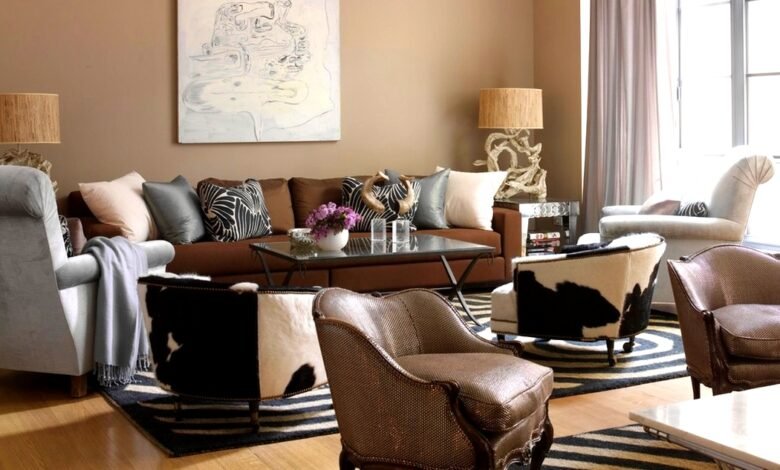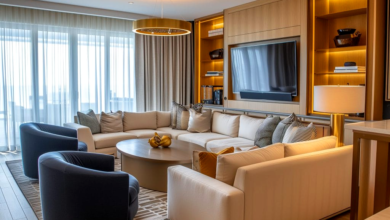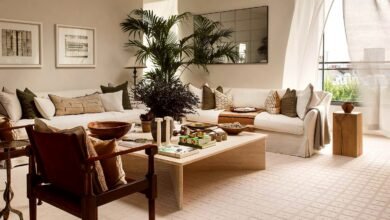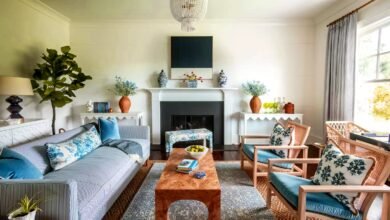How to Mix and Match Decor Styles Like a Pro
In this comprehensive guide, we’ll explore expert tips, practical strategies, and inspiring ideas to help you mix and match decor styles like a pro.

Mixing and matching decor styles is an art form that transforms your home into a unique, personalized space. By blending different aesthetics, you can create a cohesive and visually appealing environment that reflects your personality. Whether you’re combining modern minimalism with bohemian flair or rustic charm with industrial edge, mastering the ability to mix and match decor styles requires creativity, balance, and a keen eye for design. In this comprehensive guide, we’ll explore expert tips, practical strategies, and inspiring ideas to help you mix and match decor styles like a pro, ensuring your home feels both stylish and harmonious.
Why Mix and Match Decor Styles?
The trend of mixing and matching decor styles has gained popularity because it allows homeowners to break free from rigid design rules. Instead of adhering to a single aesthetic, combining styles creates a dynamic and eclectic look that tells a story. Here are a few reasons why you should embrace mix and match decor styles:
- Personalization: Blending styles lets you showcase your individuality by incorporating elements that resonate with you.
- Versatility: It allows you to use existing furniture and decor while adding new pieces, saving time and money.
- Timeless Appeal: A well-curated mix of styles feels fresh and avoids the dated look of overly uniform designs.
- Creativity: Experimenting with different aesthetics encourages innovative design choices, making your space stand out.
By learning how to mix and match decor styles, you can create a home that’s both functional and aesthetically pleasing, tailored to your lifestyle.
Understanding Different Decor Styles
Before diving into how to mix and match decor styles, it’s essential to understand the characteristics of popular design aesthetics. Here’s a brief overview of some common styles you might consider blending:
- Modern: Clean lines, neutral colors, and minimal ornamentation define modern decor. Think sleek furniture and functional design.
- Bohemian: This style embraces vibrant colors, patterns, and textures, often with a global or vintage influence.
- Rustic: Inspired by nature, rustic decor features raw materials like wood and stone, with earthy tones and cozy vibes.
- Industrial: Exposed brick, metal accents, and a utilitarian feel characterize industrial design.
- Traditional: Classic and elegant, traditional decor includes ornate furniture, rich colors, and timeless patterns like florals or damask.
- Scandinavian: Known for simplicity, functionality, and light colors, Scandinavian style emphasizes cozy minimalism.
- Mid-Century Modern: Retro-inspired with bold colors, organic shapes, and iconic furniture designs from the 1950s and 60s.
Each of these styles has distinct elements, but when thoughtfully combined, they can create a harmonious and visually appealing space. The key to successfully mix and match decor styles lies in balancing contrast and cohesion.
Step-by-Step Guide to Mix and Match Decor Styles
1. Start with a Neutral Base
A neutral foundation provides a versatile backdrop for mixing and matching decor styles. Neutral colors like white, beige, gray, or taupe allow bolder elements to shine without overwhelming the space. For example, a modern white sofa can serve as a canvas for bohemian throw pillows or a rustic wooden coffee table.
Pro Tip: Use neutral walls, floors, or large furniture pieces as your base. This creates a cohesive starting point, making it easier to layer different styles.
2. Choose a Dominant Style
When you mix and match decor styles, it’s helpful to select one dominant style to anchor the room. The dominant style sets the overall tone, while secondary styles add depth and interest. For instance, if you love Scandinavian simplicity, let that be your primary aesthetic, then incorporate bohemian textiles or industrial metal accents as accents.
Example: A Scandinavian-inspired living room with clean lines and light wood furniture can be spiced up with a vibrant bohemian rug or a mid-century modern armchair.
3. Create a Cohesive Color Palette
A unified color palette is crucial when blending decor styles. Choose 2–4 colors that complement each other and repeat them across different elements in the room. This creates visual harmony, even when combining contrasting styles like industrial and bohemian.
How to Do It:
- Pick a primary color (e.g., navy blue) and use it in larger pieces like rugs or curtains.
- Add secondary colors (e.g., mustard yellow or soft pink) through accents like pillows, artwork, or lamps.
- Use neutrals to balance bold hues and tie the room together.
By maintaining a consistent color scheme, you can mix and match decor styles without creating a chaotic look.
4. Play with Textures and Materials
Textures and materials are powerful tools for blending decor styles. Combining different textures, such as smooth leather, woven rattan, or rough-hewn wood, adds depth and interest to your space. For example, pairing a sleek modern glass table with a rustic wooden chair creates a striking contrast that feels intentional.
Ideas for Mixing Textures:
- Combine soft fabrics (like velvet or linen) with hard materials (like metal or concrete).
- Use natural elements (wood, stone) alongside polished surfaces (glass, chrome).
- Layer textiles like rugs, throws, and cushions to add warmth and dimension.
When you mix and match decor styles, textures help bridge the gap between different aesthetics, creating a cohesive look.
5. Balance Scale and Proportion
When mixing furniture from different styles, pay attention to scale and proportion. A large, ornate traditional sofa might overpower a delicate mid-century modern side table. To avoid this, ensure that furniture pieces complement each other in size and visual weight.
Tips for Balancing Scale:
- Pair a chunky rustic dining table with sleek modern chairs to create contrast without imbalance.
- Use a large statement piece, like a bohemian chandelier, to draw the eye, then balance it with simpler furniture.
- Group smaller items, like vases or candles, to create visual impact without overwhelming the space.
6. Incorporate Patterns Thoughtfully
Patterns can elevate your ability to mix and match decor styles, but they must be used strategically to avoid clashing. Stick to a limited number of patterns and ensure they share a common color or theme.
Pattern-Mixing Tips:
- Combine a bold geometric modern pattern with a subtle traditional floral print in the same color family.
- Use a neutral pattern (like stripes or herringbone) as a base to anchor more vibrant patterns (like bohemian paisley).
- Limit yourself to 2–3 patterns per room to maintain balance.
7. Use Art and Accessories as Unifying Elements
Art and accessories are perfect for tying together different decor styles. A gallery wall with a mix of modern abstract prints, vintage frames, and bohemian textiles can create a focal point that blends styles seamlessly. Similarly, accessories like vases, candles, or sculptures can bridge the gap between aesthetics.
Ideas for Accessories:
- Place a modern ceramic vase on a rustic wooden console.
- Hang industrial-style pendant lights above a traditional dining table.
- Use bohemian macramé wall hangings in a Scandinavian-inspired bedroom.
By carefully selecting art and accessories, you can mix and match decor styles while maintaining a cohesive look.
8. Embrace Contrast with Confidence
Contrast is the heart of mixing and matching decor styles. Don’t shy away from bold combinations, like pairing a sleek modern sofa with a vintage Persian rug. The key is to ensure that the contrast feels intentional rather than random.
Examples of Stylish Contrasts:
- Modern + Rustic: A minimalist white kitchen with reclaimed wood shelves.
- Bohemian + Industrial: A colorful boho rug paired with exposed brick walls and metal furniture.
- Traditional + Mid-Century Modern: A classic tufted armchair alongside a retro-inspired coffee table.
When you mix and match decor styles, contrast adds visual interest and keeps the space from feeling flat.
9. Create Focal Points
A strong focal point draws the eye and anchors the room, making it easier to blend different styles. This could be a statement piece like a bold sofa, a dramatic chandelier, or a large piece of artwork. Once you’ve established the focal point, layer in elements from other styles to complement it.
How to Create a Focal Point:
- In a living room, a vibrant bohemian rug can serve as the focal point, with modern furniture and industrial accents playing supporting roles.
- In a bedroom, a traditional four-poster bed can be the centerpiece, accented with Scandinavian bedding and mid-century modern nightstands.
10. Edit and Refine
When you mix and match decor styles, less is often more. Avoid overcrowding the space with too many elements, as this can make the room feel chaotic. Step back and edit your design by removing items that don’t contribute to the overall aesthetic.
Editing Tips:
- Keep only pieces that serve a purpose or add to the story of the room.
- Ensure there’s enough negative space to let each element breathe.
- Reevaluate your design after a few days to see if it still feels cohesive.
Common Mistakes to Avoid When Mixing and Matching Decor Styles
While learning to mix and match decor styles is exciting, it’s easy to make mistakes that disrupt the harmony of your space. Here are some pitfalls to avoid:
- Overloading with Too Many Styles: Stick to 2–3 styles to maintain cohesion. Combining too many aesthetics can make the space feel disjointed.
- Ignoring Scale: Mismatched furniture sizes can throw off the balance of the room. Ensure pieces complement each other in scale and proportion.
- Clashing Colors: A lack of a unified color palette can make the room feel chaotic. Always tie elements together with a consistent color scheme.
- Neglecting Functionality: While aesthetics are important, ensure the space remains practical for everyday use.
- Forgetting Personal Touches: Your home should reflect your personality. Incorporate meaningful items, like family heirlooms or travel souvenirs, to make the space feel authentic.
By avoiding these mistakes, you can mix and match decor styles with confidence and create a space that feels both stylish and cohesive.
Room-by-Room Ideas for Mixing and Matching Decor Styles
To inspire you, here are specific ideas for how to mix and match decor styles in different rooms of your home:
Living Room
- Style Combo: Modern + Bohemian
- How to Do It: Start with a modern sectional sofa in a neutral color like gray. Add a vibrant bohemian rug with bold patterns and layer in textured throw pillows. Incorporate a mid-century modern coffee table and industrial-style metal side tables. Finish with a gallery wall featuring eclectic artwork.
Bedroom
- Style Combo: Scandinavian + Traditional
- How to Do It: Use a Scandinavian-inspired light wood bed frame as the base. Add traditional elements like a tufted headboard or ornate bedside lamps. Layer in cozy Scandinavian textiles, such as wool throws and linen bedding, in soft colors. Accent with a vintage-inspired mirror for a touch of elegance.
Kitchen
- Style Combo: Rustic + Industrial
- How to Do It: Install rustic wooden cabinets paired with industrial stainless steel appliances. Add open shelving with reclaimed wood and metal brackets. Use modern pendant lights to add a sleek touch, and incorporate a colorful bohemian runner for warmth.
Dining Room
- Style Combo: Mid-Century Modern + Traditional
- How to Do It: Choose a mid-century modern dining table with clean lines and pair it with traditional upholstered chairs in a rich fabric. Add a statement chandelier with industrial elements and a vibrant rug to tie the styles together.
Bathroom
- Style Combo: Modern + Bohemian
- How to Do It: Install modern fixtures like a sleek vanity and minimalist mirror. Add bohemian flair with patterned tiles, woven baskets, and lush green plants. Use neutral towels to balance the bold patterns.
By applying these ideas, you can mix and match decor styles in a way that feels intentional and cohesive in every room of your home.
Tools and Resources for Mixing and Matching Decor Styles
To make the process of mixing and matching decor styles easier, consider using these tools and resources:
- Mood Boards: Create a digital or physical mood board to visualize how different styles, colors, and textures will work together. Tools like Canva or Pinterest are great for this.
- Design Apps: Apps like Houzz or RoomSketcher allow you to experiment with layouts and styles virtually.
- Color Palette Generators: Websites like Coolors or Adobe Color help you create cohesive color schemes.
- Inspiration Sources: Browse design magazines, Instagram, or home decor blogs for ideas on how to mix and match decor styles.
Real-Life Examples of Mixing and Matching Decor Styles
To further illustrate how to mix and match decor styles, here are two real-life-inspired examples:
Example 1: Eclectic Urban Loft
- Styles: Industrial, Bohemian, Modern
- Description: In a spacious loft with exposed brick walls (industrial), the homeowner added a modern sectional sofa in charcoal gray. A vibrant bohemian rug with geometric patterns anchors the space, while a sleek glass coffee table adds a modern touch. Macramé wall hangings and lush plants bring in bohemian flair, and industrial pendant lights complete the look.
Example 2: Cozy Cottage Retreat
- Styles: Rustic, Scandinavian, Traditional
- Description: A cozy cottage features a rustic wooden dining table paired with Scandinavian-style white chairs. A traditional chandelier adds elegance, while Scandinavian textiles, like wool throws and neutral cushions, create a cozy vibe. A vintage-inspired mirror and fresh flowers add a touch of charm.
These examples show how thoughtful combinations of styles can create unique and inviting spaces.
Final Tips for Mastering the Art of Mixing and Matching Decor Styles
To truly mix and match decor styles like a pro, keep these final tips in mind:
- Trust Your Instincts: Your home should reflect your personality, so don’t be afraid to experiment with styles you love.
- Start Small: If you’re new to mixing styles, begin with small spaces like a bathroom or entryway before tackling larger rooms.
- Seek Inspiration: Visit showrooms, browse design blogs, or follow interior designers on social media to spark ideas.
- Be Patient: Creating a cohesive look takes time. Don’t rush the process—layer elements gradually to achieve the perfect balance.
By following these strategies, you can confidently mix and match decor styles to create a home that’s uniquely yours.
Conclusion
Mixing and matching decor styles is a rewarding way to infuse your home with personality, creativity, and charm. By starting with a neutral base, choosing a dominant style, and carefully balancing colors, textures, and patterns, you can create a space that feels both cohesive and dynamic. Whether you’re blending modern and bohemian, rustic and industrial, or Scandinavian and traditional, the key is to embrace contrast while maintaining harmony. With the tips and ideas in this guide, you’re well-equipped to mix and match decor styles like a pro, transforming your home into a stylish and inviting sanctuary.











